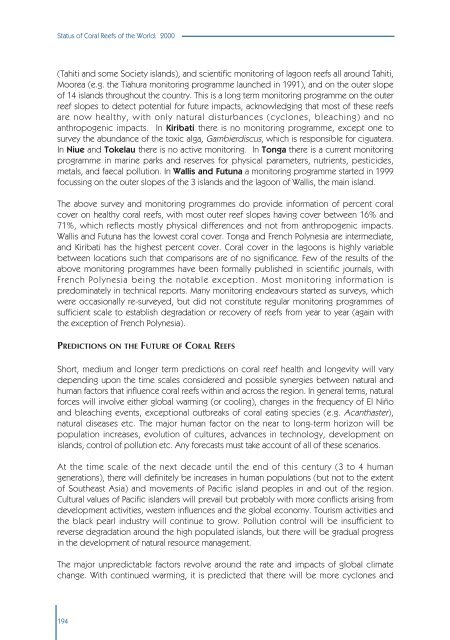Status of Coral Reefs of the World 2000
Status of Coral Reefs of the World 2000.pdf
Status of Coral Reefs of the World 2000.pdf
- No tags were found...
Create successful ePaper yourself
Turn your PDF publications into a flip-book with our unique Google optimized e-Paper software.
<strong>Status</strong> <strong>of</strong> <strong>Coral</strong> <strong>Reefs</strong> <strong>of</strong> <strong>the</strong> <strong>World</strong>: <strong>2000</strong><br />
(Tahiti and some Society islands), and scientific monitoring <strong>of</strong> lagoon reefs all around Tahiti,<br />
Moorea (e.g. <strong>the</strong> Tiahura monitoring programme launched in 1991), and on <strong>the</strong> outer slope<br />
<strong>of</strong> 14 islands throughout <strong>the</strong> country. This is a long term monitoring programme on <strong>the</strong> outer<br />
reef slopes to detect potential for future impacts, acknowledging that most <strong>of</strong> <strong>the</strong>se reefs<br />
are now healthy, with only natural disturbances (cyclones, bleaching) and no<br />
anthropogenic impacts. In Kiribati <strong>the</strong>re is no monitoring programme, except one to<br />
survey <strong>the</strong> abundance <strong>of</strong> <strong>the</strong> toxic alga, Gambierdiscus, which is responsible for ciguatera.<br />
In Niue and Tokelau <strong>the</strong>re is no active monitoring. In Tonga <strong>the</strong>re is a current monitoring<br />
programme in marine parks and reserves for physical parameters, nutrients, pesticides,<br />
metals, and faecal pollution. In Wallis and Futuna a monitoring programme started in 1999<br />
focussing on <strong>the</strong> outer slopes <strong>of</strong> <strong>the</strong> 3 islands and <strong>the</strong> lagoon <strong>of</strong> Wallis, <strong>the</strong> main island.<br />
The above survey and monitoring programmes do provide information <strong>of</strong> percent coral<br />
cover on healthy coral reefs, with most outer reef slopes having cover between 16% and<br />
71%, which reflects mostly physical differences and not from anthropogenic impacts.<br />
Wallis and Futuna has <strong>the</strong> lowest coral cover. Tonga and French Polynesia are intermediate,<br />
and Kiribati has <strong>the</strong> highest percent cover. <strong>Coral</strong> cover in <strong>the</strong> lagoons is highly variable<br />
between locations such that comparisons are <strong>of</strong> no significance. Few <strong>of</strong> <strong>the</strong> results <strong>of</strong> <strong>the</strong><br />
above monitoring programmes have been formally published in scientific journals, with<br />
French Polynesia being <strong>the</strong> notable exception. Most monitoring information is<br />
predominately in technical reports. Many monitoring endeavours started as surveys, which<br />
were occasionally re-surveyed, but did not constitute regular monitoring programmes <strong>of</strong><br />
sufficient scale to establish degradation or recovery <strong>of</strong> reefs from year to year (again with<br />
<strong>the</strong> exception <strong>of</strong> French Polynesia).<br />
PREDICTIONS ON THE FUTURE OF CORAL REEFS<br />
Short, medium and longer term predictions on coral reef health and longevity will vary<br />
depending upon <strong>the</strong> time scales considered and possible synergies between natural and<br />
human factors that influence coral reefs within and across <strong>the</strong> region. In general terms, natural<br />
forces will involve ei<strong>the</strong>r global warming (or cooling), changes in <strong>the</strong> frequency <strong>of</strong> El Niño<br />
and bleaching events, exceptional outbreaks <strong>of</strong> coral eating species (e.g. Acanthaster),<br />
natural diseases etc. The major human factor on <strong>the</strong> near to long-term horizon will be<br />
population increases, evolution <strong>of</strong> cultures, advances in technology, development on<br />
islands, control <strong>of</strong> pollution etc. Any forecasts must take account <strong>of</strong> all <strong>of</strong> <strong>the</strong>se scenarios.<br />
At <strong>the</strong> time scale <strong>of</strong> <strong>the</strong> next decade until <strong>the</strong> end <strong>of</strong> this century (3 to 4 human<br />
generations), <strong>the</strong>re will definitely be increases in human populations (but not to <strong>the</strong> extent<br />
<strong>of</strong> Sou<strong>the</strong>ast Asia) and movements <strong>of</strong> Pacific island peoples in and out <strong>of</strong> <strong>the</strong> region.<br />
Cultural values <strong>of</strong> Pacific islanders will prevail but probably with more conflicts arising from<br />
development activities, western influences and <strong>the</strong> global economy. Tourism activities and<br />
<strong>the</strong> black pearl industry will continue to grow. Pollution control will be insufficient to<br />
reverse degradation around <strong>the</strong> high populated islands, but <strong>the</strong>re will be gradual progress<br />
in <strong>the</strong> development <strong>of</strong> natural resource management.<br />
The major unpredictable factors revolve around <strong>the</strong> rate and impacts <strong>of</strong> global climate<br />
change. With continued warming, it is predicted that <strong>the</strong>re will be more cyclones and<br />
194
















